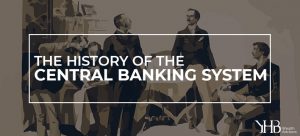

The history of the development of a Central Banking system in this country helps you understand exactly how much impact the decisions made and actions taken by the Federal Reserve impact the investment markets. It all starts literally at the birth of our Nation.
1775 – 1791
To finance the American Revolution, the Continental Congress printed the new nation’s first paper money. Known as “continentals,” the fiat money notes were issued in so much quantity they led to inflation, which, though mild at first, rapidly accelerated as the war progressed. Eventually, people lost faith in the notes, and the phrase “Not worth a continental” came to mean “utterly and completely worthless.”
1791 – 1811
At the urging of then Treasury Secretary Alexander Hamilton, Congress established the First Bank of the United States, headquartered in Philadelphia, in 1791. This was the first attempt by the United States to create a “Central Bank” authority to control the money supply. It was the largest corporation in the country and was dominated by big banking and money interests. Many rural Americans uncomfortable with the idea of a large and powerful bank opposed it. When the bank’s 20-year charter expired in 1811 Congress refused to renew it by one vote, and it went away.
1816 – 1836
For several years, the country had no central bank regulatory body, but by 1816, the political climate was once again inclined toward the idea of a central bank; by a narrow margin, Congress agreed to charter the Second Bank of the United States. And we had our second “Central Bank” experiment. But when Andrew Jackson, was elected president in 1828, he vowed to kill it. His attack on its banker-controlled power touched a popular nerve with Americans, and when the Second Bank’s charter expired in 1836, again it was not renewed.
1836 – 1865
We had no central bank, but State-chartered banks and unchartered “free banks” took hold during this period, issuing their own currency notes, redeemable in gold. Banks also began offering demand deposits to enhance commerce. There were literally hundreds of small, in some cases single branch, banks printing and issuing their own form of currency. This was also the period when it became more commonplace to do business with checks, rather than exclusively with cash. In response to the rising volume of check transactions, the New York Clearinghouse Association was established in 1853 to provide a way for banks to exchange checks and settle accounts. (I collect antique stock certificates and currency notes and have a number of the stock certificates of these State chartered banks. In our office in Winchester I also have a framed $10 currency note issued to a gentleman who lived in Leesburg by the “The Bank of the Valley” in Winchester in 1856.)
1863
During the Civil War, the National Banking Act of 1863 was passed, providing for the first nationally chartered banks, whose circulating currency notes had to be backed by U.S. government securities. An amendment to the act required taxation on state bank notes but not national bank notes, trying to eliminate State issued currency notes, and effectively creating a uniform currency for the nation. However, despite taxation on their notes, state banks continued to flourish due to the growing popularity of demand deposits, which had taken hold during the Free Banking Era.
1873 – 1907
Although the National Banking Act of 1863 established some measure of currency stability for the growing nation, bank runs and financial panics continued to plague the economy. In 1893, a banking panic triggered the worst depression the United States had ever seen up to that point, and the economy stabilized only after the intervention of financial mogul J.P. Morgan – he literally acted to save the nation. It was clear that the nation’s banking and financial system needed serious attention.
1907 – 1912
In 1907, a bout of speculation on Wall Street ended in failure, triggering a particularly severe banking panic. J.P. Morgan was again called on to avert disaster. By this time, there was a growing consensus among all Americans that a central banking authority was needed to ensure a healthy banking system and provide for a stable currency. Woodrow Wilson solicited expert advice from Virginia Representative Carter Glass, and H. Parker Willis, a professor of economics at Washington and Lee University. Throughout most of 1912, Glass and Willis labored over a central bank proposal, and by December 1912, they presented Wilson with what would become, with some modifications, the Federal Reserve Act.
1913
For just about a year, the proposal was hotly debated and modified. By December 1913, when President Woodrow Wilson signed the Federal Reserve Act into law, it stood as a classic example of compromise—a decentralized central bank that balanced the competing interests of private banks and populist sentiment. It established a system of 12 regional Federal Reserve banks.
The following decades brought numerous challenges to the U.S. and global economies (WW1 and WW2, the Great Depression, the Dotcom Bubble, 9/11, and the 2008 Financial Crisis), which in turn brought many changes to the way in which the Federal Reserve operated and the impact they had on economic growth and currency operations.
The point of all this history – which I know some of you probably think is really boring – is to make the point that the central banking system we have today didn’t come into being overnight. There was a lot of trial and error.


Randy has more than 15 years of experience managing financial assets for individuals, retirement plans and businesses. Randy joined YHB | Wealth Advisors in January of 2018 and serves as the Director of Wealth Management. Prior to entering the professional wealth management field, he enjoyed building entrepreneurial business ventures from start-up to eventual sale and providing accounting services for public and private firms.
